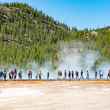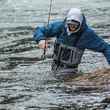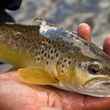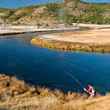The bright, 14-inch rainbow trout launched into the air, silhouetting itself against the June sky, mirrored in the shining surface of the stream as it fell back to the water with a satisfying smack. It was not the grandest rainbow of my life, but the one that brought me the most joy. It was my first Silver Creek rainbow. My first western trout. Yes, I said to myself. This is it!
Just a day earlier, my buddy Bert and I had been motoring along US-20 across Idaho, two Virginia boys bound for Sun Valley and our jobs for that summer of 1967. We had made our way west over the previous five days in Bert's reluctant, second-hand Chevy-II, stopping here and there for minor repairs, arriving at campsites late in the evening, and leaving early the next morning. Sometimes, not even camping, just driving. We were both nineteen, fresh from our first year in college, looking to spend the summer months catching trout. We planned to support ourselves (earn gas money) through six-day-a-week, low-level jobs wrangled for us in Sun Valley by my neighbor and our fly-fishing mentor, Joe Brooks.
As we rolled along US-20, Bert driving and me navigating, we kept a keen eye on the road. First, trying to figure out the admonitions painted on the asphalt — "Don't Be A GUBERIF" (“FIREBUG,” when viewed in the rearview mirror) — and second, looking for Silver Creek.
“Slow down, Bert. Our Rand McNally says we’re getting close. It has to be here somewhere.”
Soon, we saw a small green sign by a modest bridge over a placid, unassuming stream. “Silver Creek,” it said. If ever there was an understated announcement of angling heaven, this was it.
We took the first dirt road on the right and wound down to the stream for a closer look. For a couple of kids who, two weeks before, were stalking brookies in the Blue Ridge Mountains, this was a “not-in-Kansas-anymore” moment. Back home, the norm was short casts underneath and between tree limbs and rhododendrons, in narrow, plunging, rock-filled rills. Here, long leaders and longer lines would be required, with high backcasts to clear the tules along the bank. Matching the myriad hatches, all of which were new to us, would challenge our ingenuity and meager fly collections.
Joe had warned us that Silver Creek rainbows were hard to fool — harder than we could then imagine.
We stood there, held in thrall by the silken stream that coursed through its broad valley, surrounded by sagebrush hills. We could have studied the currents, the hatches, the rises for hours, but we had to get to Sun Valley to meet our boss — and, just as important, get our fishing licenses. We hurried on.
Don Anderson was a classic Idaho native and guide — friendly, but no-nonsense. And, as Sun Valley Sports Director, The Boss. As a close friend of Ernest Hemingway, he had once physically restrained him from shooting himself. Later, he was one of Hemingway’s pallbearers — facts he never mentioned to us. Don had plenty of tales of “the Old Days” on Silver Creek, often mentioning his dear friend (gone ten years), Taylor “Bear Tracks” Williams, with whom he had spent many an hour on the Sun Valley Ranch, hunting pheasants, shooting ducks, or casting for trout.
On our first visit, Don filled us in on navigating the dirt roads and access points (don’t stray onto the private Purdy Ranch!). And he couldn't help but recall the days when the catch limit on Silver Creek was eight pounds plus one additional trout — which could sometimes be met with three fish. Those were the days — his days. Our days were about to begin.
Our jobs ended at five o’clock every evening. We’d leave the Valley soon after, grab snacks at Atkinson's Market in Ketchum, and head for the creek. When we had a full day off, we’d often haunt the water on the Sun Valley Ranch (now The Nature Conservancy’s Silver Creek Preserve) from morning’s first hatch to evening’s last light.
Silver Creek’s rainbows weren't the slap-happy Blue Ridge brookies back home. These fish knew when brunch began, when it was Siesta, when dinner was served, and what morsels were for dessert. They knew what they wanted — size, color, location on, in, or under the surface, and how they wanted it served: no drag. thank you very much. Most days we stood bewildered in the middle of rising, dimpling, bulging (or whatever they were doing) trout; fly boxes open, our heads swiveling, our self-confidence plummeting. The few fish we caught, we caught by accident.

At least there were no witnesses to our futility, other than the trout. We seldom saw other anglers. If any appeared, we felt cramped and cranky, fleeing from the sounds of voices, seeking sections of stream more remote. We thought of Silver Creek and its trout as ours alone.
In time, we improved at presenting our flies, making them more acceptable to the resident rainbows. And we caught some “decent” fish, though every fish that year was more than decent to us.
After that first season, I returned to Sun Valley and Silver Creek for two more summers, guiding my last. While I was fishing alone one day in a quiet spot downstream from the Highway 20 bridge, a fish gently inhaled my hair frog, which I’d tied on as an experiment. That fish, one I never saw, dove deep and headed upstream before my frog came free and floated to the surface with a terrified look on its face.
Don grinned when I told him of the encounter. “Yes,” he said, “that's what the big ones did back in the old days. No jumping. They went straight to the bottom like a submarine and cruised away.” Don often opted for the big-fly approach over match-the-hatch tomfoolery, so I think the hair-frog approach caught his fancy. He would always smile and chuckle when we told him of our latest triumphs (or, more often, frustrations) on Silver Creek, and such visits often brought up tales from years past.

That summer of 1967, we asked Don to join us on Silver Creek. He was reluctant but, at last, joined us one evening, fishing apart, perhaps lost in his memories of old times, old friends. As we put away our rods, we could tell from the look in his eyes that his heart hadn’t been in it. We had fished one Silver Creek that evening — he another. For him, the best days were yesterdays.
To Bert and me, it was all new and fabulous. We reveled in sunny Idaho summer days, each more perfect than the one before. We marveled at hatches that transformed a calm thread of current to a riot of risers and spinner falls that left scum lines on our Seal-Dri’s. We gloried in the liquid slurp of feeding rainbows, the ever-present bell-like trills of blackbirds, the press and gurgle of water against our waders — the subdued symphony of the stream.
In the evenings, we lingered in the currents, bathed in sunset afterglow, craving one more cast, one last fish. We would leave the stream when darkness came, our feet finding familiar paths through the sage. If we had fished apart, we would compare notes on hatches and fish, testing the limits of friendly exaggeration, cocking our ears to the first coyote call of the night.
Silver Creek today is not the Silver Creek we knew. Like everything else, it has changed. Large brown trout now garner much attention there, whereas picky rainbows were the fish that we stalked in our day. And it is busier, for sure — now frequented by moose (which we never saw) and many more anglers.
When we first fished the Ranch, Silver Creek there was unmanaged. Over the years, silt in runoff from upstream ranches accumulated, and runs and feeding lanes that once tested the tops of our waders became shallow, unproductive slogs. Now, Silver Creek is in the care of dedicated professionals who work with local landowners, striving to protect it and restore it as best they can.

Bert and I recall the joy Silver Creek gave us — the hours spent in its splendid embrace. We have our memories. Others will have theirs in years to come.
I did not realize it then, but that first summer on Silver Creek was a turning point, a divide not only in my fishing life but also in how I viewed the arc of my life — the studies I wanted to pursue and how and where I wanted to live.
I don’t return to Silver Creek often, but when I do, I always pause to savor the view from the hillside road. I stop, get out, and stand and remember. I recall our first summer on The Creek, days ephemeral as those of any mayfly. I feel Don’s presence — the things he said and those he couldn’t put into words. And now I understand.
When my day is done, I wish for some of my ashes to make it into Silver Creek, slipping along its graceful meanders, spiraling through its system. I hope that a bit of me, if only a few atoms, will take flight into the air above that sweet sliver of stream, breaking free, reaching for the bright blue Idaho sky above.































Comments
Steven replied on Permalink
My dad told me that the native rainbows in Silver Creek back in the mid 50s were mostly silver green with a pink stripe on their lateral line with very few spots. They called them silver trout. They introduced another species of rainbow I believe from the McCloud River in California silver trout were bred out of existence. I caught some silver trout in the small spring-fed streams in the Magic Valley on the Twin Falls side of the canyon here is a picture of one. It has absolutely no spots except on a dorsal adipose and tail fin. Very unusual and unique
Robbins Church replied on Permalink
Very interesting. From genetic studies, rainbows are not "native" to Silver Creek. Rainbows populated the stream either through hatchery escape or intentional plants, for which records are sparse or non-existent. The result is a mixture of legacies from a variety of strains.
Pages